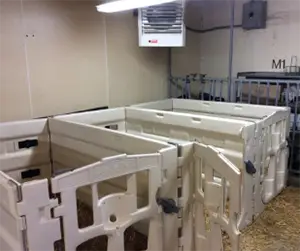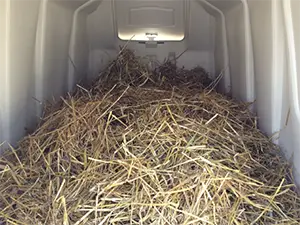
Safely warm newborn calves
 By Dr. Noah Litherland
By Dr. Noah LitherlandEvery one of us in the dairy industry has an inborn fondness for cattle, and value newborn calves and the promise they bring. Let’s get wise about thermal support for our calves in the first 24 hours of their lives during cold weather.
Calves born in cold weather have received adaptive signals from their dam, resulting in increased birth bodyweight, increased hair coat density, and carrying more body fat reserves. The calf’s hair coat works as an insulator by trapping air and creating a boundary between the body and the chilly ambient air. Towel-drying calves aids in fluffing this hair coat. Pay special attention to drying the ears as this will help reduce the risk of frost damage.
Calves born during cold weather need to be placed in a warm environment (60 to 70 degrees F) for the first 12 to 24 hours until they have completely dried and had an opportunity to absorb colostrum nutrients and IgG from 3 to 4 quarts of colostrum (750 to 1,200 grams of colostrum solids). Warming systems should be designed to minimize risk of fire.  Safe warming room heating strategies include:
Safe warming room heating strategies include:
- In-floor heating
- Fixed radiant heaters
- Forced air heating
Risk of fire has proven to be too great with heat lamps. Common problems with heat lamps are height of suspension, complacency with method of suspension over calves, and fire risk if heat lamps fall into bedding. Red infrared bulbs reach a temperature of greater than 700 degrees F and white infrared bulbs reach a temperature of more than 450 degrees F. For reference, paper (and perhaps dry straw) ignites at 451 degrees F.
 Clamps that come with most heat lamps and flimsy wire hangers should not be relied upon to keep the heat lamp suspended. If a heat lamp must be used, be sure the lamp is securely fixed and placed high enough that the lamp cannot be knocked down into the bedding. Smoke detectors are available that will contact your phone, which can help with response time when emergencies arise.
Clamps that come with most heat lamps and flimsy wire hangers should not be relied upon to keep the heat lamp suspended. If a heat lamp must be used, be sure the lamp is securely fixed and placed high enough that the lamp cannot be knocked down into the bedding. Smoke detectors are available that will contact your phone, which can help with response time when emergencies arise.
 Once calves are dry, supplemental heat is rarely needed. Provide calves with properly fitted calf jackets, deep straw bedding, and protection from wind, snow, and other inclement weather.
Once calves are dry, supplemental heat is rarely needed. Provide calves with properly fitted calf jackets, deep straw bedding, and protection from wind, snow, and other inclement weather.
About the author: Dr. Noah Litherland is the Vita Plus dairy youngstock technical specialist. He grew up on a diversified livestock farm in central Illinois and was active in 4-H and FFA as a youth. He earned his bachelor’s, master’s and Ph.D. from the University of Illinois, focusing on dairy cattle nutritional physiology. He worked as a dairy extension specialist at Oklahoma State University from 2006 to 2008 and then as a dairy nutritionist at the University of Minnesota until 2014. At Minnesota, Litherland served as the faculty supervisor of dairy research on the St. Paul campus.
| Category: |
Animal handling Dairy Performance Equipment Facility design Safety Winter calf care |

